Stainless steel and chrome were once the metals of choice, but the trend, led by the United States and now moving to the UK, is shifting to warm and subtle tones of brass, burnished gold, or hammered bronze, said Financial Times.
According to AjMadison, since brass is an eco-friendly, recyclable, and hygienic material, it is gaining popularity and acknowledgment by the day. In addition, with the rising environmental concerns, the use of brass as a sink material is also rising.
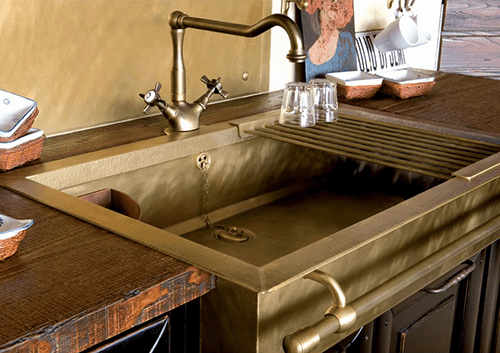
While brass is durable and has antimicrobial properties, it is susceptible to dents, tarnish, scratches, and verdigris (green residues). Hence, they need extra care and maintenance. But, they don’t demand special, expensive maintenance -simple regular cleaning and caring are enough.
There are ways to prevent these problems, but what if your brass sink is already damaged? No need to worry! We got you. There are simple ways to clean your brass sinks.
Ways to Clean a Brass Sink
Before getting into the specifics of cleaning brass sinks, you need to pay attention to certain things.
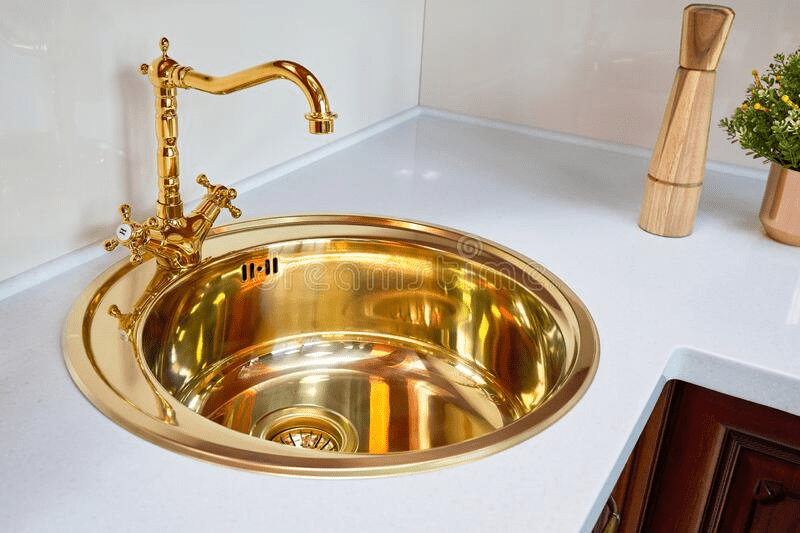
Purity of The Brass Material
While you have a brass sink, it might not be a pure brass sink. Therefore, before you start cleaning brass, double-check the sink material you’re cleaning. Only because your sink looks like brass doesn’t necessarily imply that it is pure brass.
Most of the sinks are brass-plated, and the cleaning process may damage the brass-plated sink.
For checking whether it is pure, solid brass or not, perform this test.
Take a magnet and check if it clings to the metal. If the magnet sticks to the sink, it isn’t pure brass.
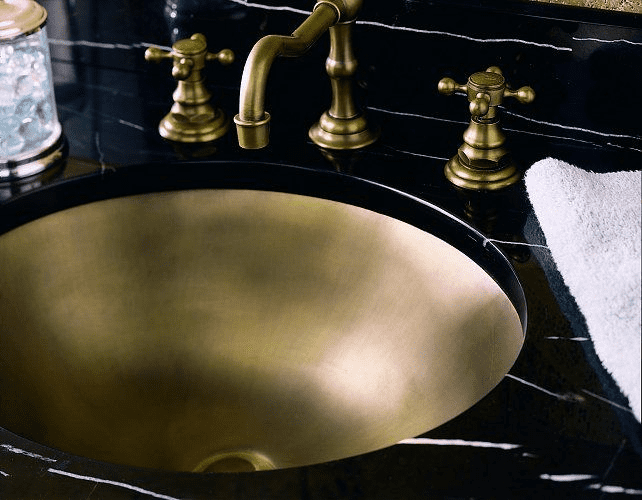
Lacquered Brass Sink
Another thing you should check before using cleaning methods is whether the brass sink is lacquered. A thin, lustrous coating called lacquer helps to protect the brass sink from getting tarnished.
However, chemical or acid-based cleaning methods will harm the lacquered brass sinks.
Therefore, consider taking your lacquered sink to a professional instead of cleaning it at your home.
Tip -If you plan to use any cleansers or products on your brass sinks to clean them, ensure that you possess a non-lacquered brass sink.u
Understand the Problem
Note -Brass sinks are expensive, and hence if you’re doubtful about any cleaning methods, it is always better to take the sink to a professional.
Now, let us dive in and discuss the natural methods for cleaning a brass sink.
Natural Methods
The following methods are safe to treat minor stains, tarnish, and buildup from brass sinks.
Caution -Before using any cleaning method, always test them on inconspicuous sink areas.
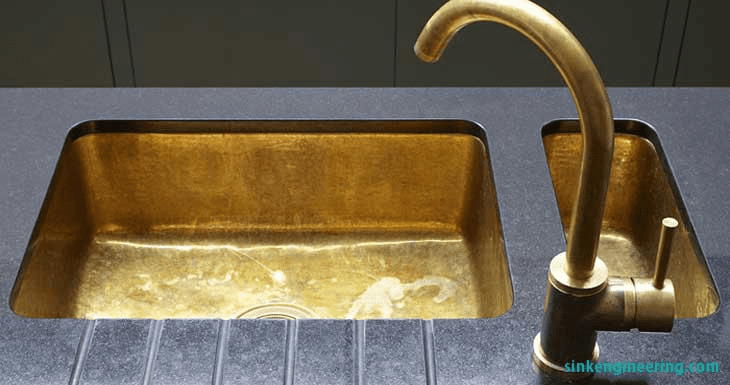
Soap and Water
Besides removing stains and buildup, soap and water also can be a daily cleaning method for brass. Plus, if you have a brass-coated sink and not a pure brass sink, use dishwasher soap (or mild detergents) and water; anything more abrasive might harm the brass coating.
A simple method,
- Take your favorite mild detergent or dishwashing soap and water.
- Apply this all over the sink.
- With a gentle scrubber, start scrubbing the sink.
- Once done, rinse the sink with normal water and wipe dry.
However, if you own a lacquered brass sink, you should not use commercial products or aggressive cleaning methods. Besides, it is pretty easy to clean a lacquered brass sink. Using a soft, dampened cloth, wipe the sink.
Unfortunately, it is not as easy as wiping the sink with a damp cloth for a non-lacquered brass sink. These types of sinks require different cleansing agents. Following are some of the many methods effective as well as safe for cleaning a brass sink.
Lemon
Lemon acts as a cleaning and a whitening agent while cleaning tarnish from brass sinks. When Lemon juice is combined with baking soda or salt, it helps eliminate the tarnish settled onto your brass sinks.
With Baking Soda :
While using lemon with baking soda,
- form a paste mixing a tablespoon of baking soda with the juice of half a lemon.
- Smear the paste onto a soft microfiber cloth and start buffing.
- Buff the sink thoroughly with the paste.
- Once you notice that the tarnish is gone, rinse the sink with lukewarm water.
- Finally, dry the sink and repeat the method if necessary.
Tip –If the tarnish seems heavy and stubborn on your brass sinks, let the paste rest onto the sink for at least 30 minutes until you rinse.
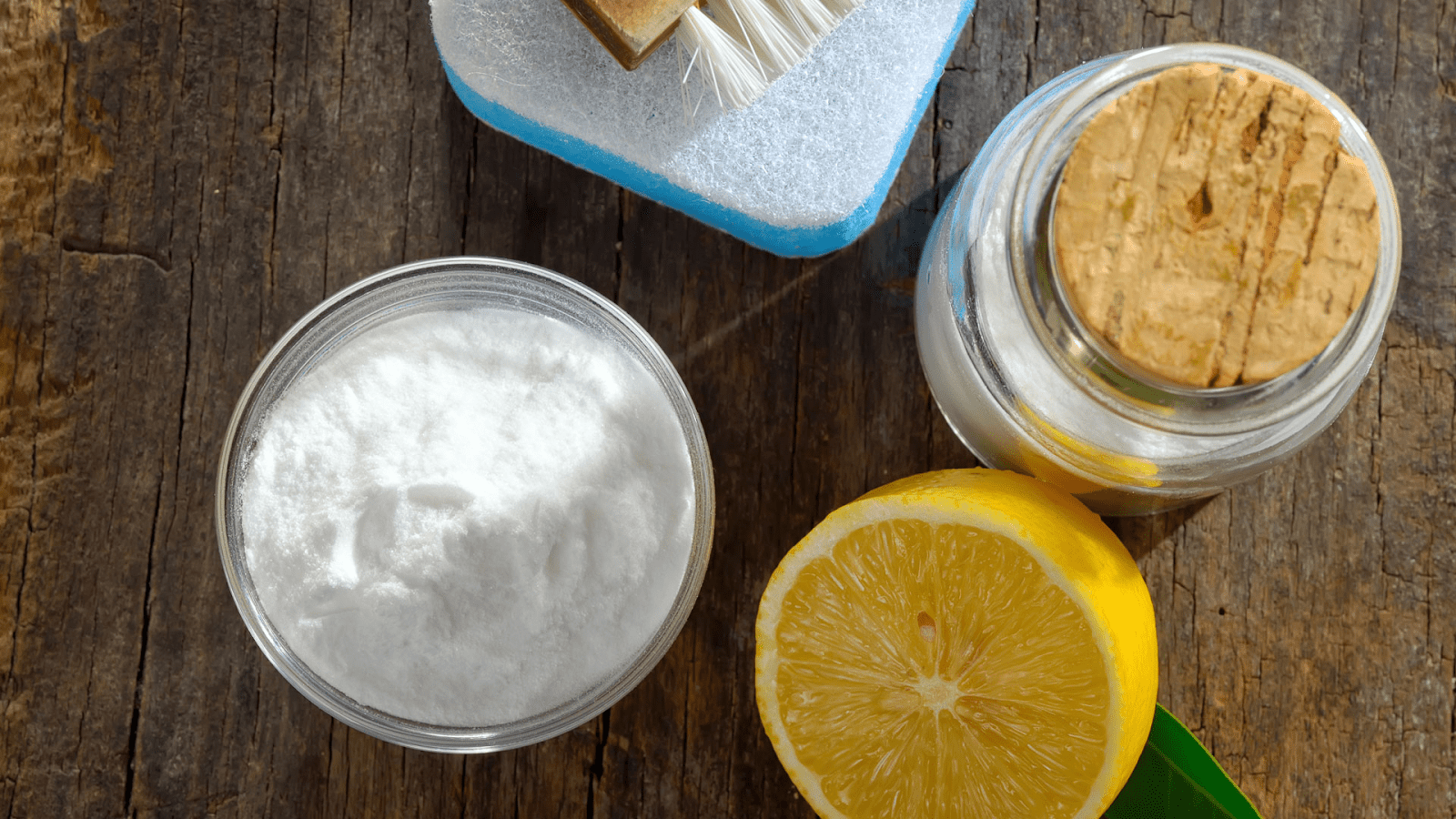
With Salt :
Another simple method for eliminating tarnish and other stains is lemon juice and table salt.
In this method,
- Cut the lemon into two halves.
- Dip the half-cut lemon into a bowl of salt.
- Now, start buffing the sink with lemon and salt.
- As you buff, squeeze the juice from the lemon.
- Lastly, using warm water, rinse the sink.
- Wipe dry with a soft cloth.
Salt, White Vinegar, and Flour
Three readily available items at our homes -salt, white vinegar, and flour help you remove dirt from your brass sinks and make them clean. Salt will act as an abrasive cleaner, vinegar as an acid, and flour as a thickener to clean brass sinks.
To use these items,
- Stir a teaspoon of salt in ½ cup of vinegar until dissolved.
- Add about two tablespoons of flour to the salt-vinegar solution forming a paste.
- Apply the paste over the brass sink thoroughly.
- Let it rest until dry. (approx. 10 minutes)
- Now, rinse and wipe the paste from the sink.
- Using a soft dry cloth, wipe and dry the sink.
Tip -Paste of salt, vinegar, and flour is also effective on corroded brass items.
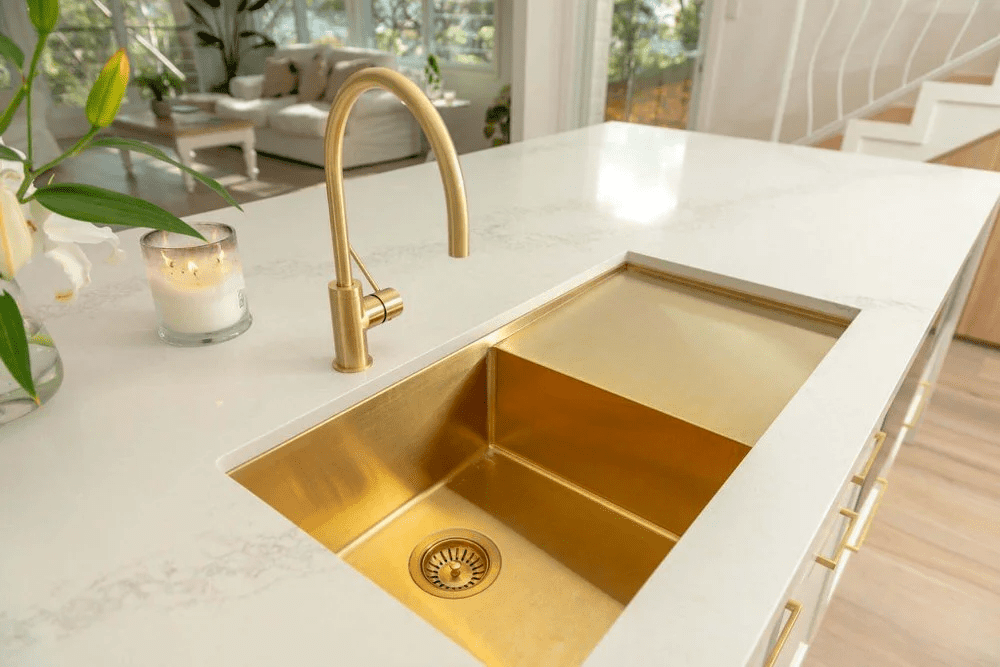
Ketchup or Tomato Paste/sauce
You might think, How is tomato ketchup or sauce going to clean my brass sink? But, believe it or not, tomato sauce is a simple yet direct method to repair your damaged brass sinks.
- Pour some tomato sauce or ketchup over your brass sink.
- Let it rest for about half an hour in the sink.
- Rinse the sink using warm water.
- With a clean cloth, dry the sink.
Toothpaste
Toothpaste is another household item to your rescue. Just like toothpaste helps us clean and whiten our teeth, it does the same to brass.
Note -Always use plain, unflavored toothpaste to clean brass sinks.
In this method,
- Spread a thin layer of toothpaste onto the sink.
- Allow it to sit for several minutes.
- Then, remove the toothpaste using a clean cloth.
- Now, wash your sink with cool water.
- Dry the sink with a microfiber towel.
Besides cleaning your brass sinks, toothpaste will also help you as brass polish for your beautiful brass sinks.
Non-natural methods
Along with natural cleaning methods, there are some non-natural cleaning methods. They have been found effective as well as safe for cleaning brass sinks.
Blue Magic Metal Cleaner
Most brass cleaners come in when you have an uncoated brass sink that oxidizes and darkens over time. One such cleaner is Blue magic metal cream. This product contains ammonia which helps in eliminating the darkness and coating the brass with a protective layer.
- Stir the product well.
- Using a soft dry cloth, apply some blue magic cream over the sink.
- Rub the cream until you see a black film appearing.
- Now, use a clean cloth to buff the sink thoroughly.
- And you’re done.
Check out the video to see after and before the result.
Brasso
Similar to Blue magic, Brasso is a cream-based cleaning product that does wonders while cleaning brass items.
Use Brasso same like blue magic,
- Shake the product well.
- Start by dipping a clean cloth in Brasso.
- Thoroughly scrub the brass surface with this cloth.
- After seeing a brighter brass sink, buff the sink again with another clean cloth.
- And you’re good to go!
After using Brasso or Blue magic, there is no need to rinse or wash the sink.
Bar Keeper’s Friend or BKF
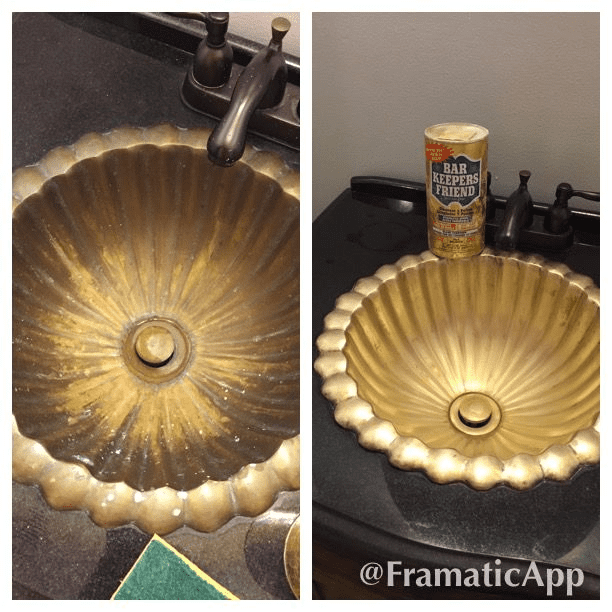
Bar Keeper’s Friend is now a go-to choice for cleaning various materials without damaging the items. Plus, this product saves both energy and time.
To use this,
- Apply a small amount of BKF to a soft, damp cloth.
- Using this cloth, start buffing your brass sink and work BKF well onto the sink.
- Within no time, you will see the shine returning to the sink.
- For heavy stains, you might need a little bit of scrubbing.
- Once done, wipe away the product with a clean cloth.
- Rinse and dry the sink.
Tip -It is always safe to wear gloves while using non-natural products.
Twinkle Brass and Copper Cleaning Kit
The product is easy to use. In addition, it helps to remove tarnish and stains without scrubbing, without any mess, and even without waste.
For using this cleaning kit,
- First, rinse the brass sink with hot water.
- Apply the cleaner using the applicator provided with the kit.
- Then, promptly rinse the sink again with hot water.
- Finally, use a clean cloth to wipe and dry the sink.
That is all you need to do if you’re cleaning with a Twinkle brass and copper cleaning kit.
WD-40
WD-40 acts as a multi-purpose lubricant and cleaning agent for various materials. Again, a very easy-to-use product.
- Start by spraying WD-40 onto a clean dry cloth.
- Using this cloth, start rubbing the brass sink in circular motions.
- Within no time, you will find your brass sinks restoring their shine.
How to Prevent Brass Sinks from Tarnishing?
Brass is an alloy of copper and zinc that tends to tarnish after coming in contact with oxygen. If left unnoticed, the tarnish might settle onto the brass surface and make it difficult to eliminate.
Hence, prevention is always better than cure. Prevent your beautiful and aesthetic looking brass sinks from tarnishing or darkening by using a:
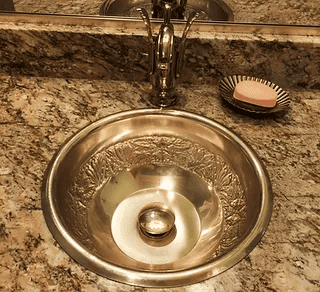
Polyurethane Sealer
A thin coating of clear sealer will prevent oxidation, and as a result, will protect the sink.
Even though the majority of the brass sinks come with a sealer coating, the coating might fade away over time. Therefore, you need to re-coat the brass sink with a polyurethane sealer.
Moreover, the polyurethane sealer will protect the brass without discoloring the sink.
These were some of how you can clean and restore the shine of your aesthetic brass sinks. Happy Cleaning!
Check out this video for how to clean a tarnished brass sink :
![Chrome Vs. Stainless Steel Faucets: [An In-Depth Analysis] Chrome Vs. Stainless Steel Faucets: [An In-Depth Analysis]](https://houseadorable.com/wp-content/uploads/2023/03/51gDGcVWBL._AC_UF10001000_QL80_-250x250.jpg)
![What Are Kitchen Sinks Made Of ? [13 Types+Pros & Cons] What Are Kitchen Sinks Made Of ? [13 Types+Pros & Cons]](https://houseadorable.com/wp-content/uploads/2022/01/Sink-MAterial.jpg)
![Ceramic vs Stainless Steel Sink [A Detailed Analysis] Ceramic vs Stainless Steel Sink [A Detailed Analysis]](https://houseadorable.com/wp-content/uploads/2021/12/Ceramic-vs-ss.jpg)
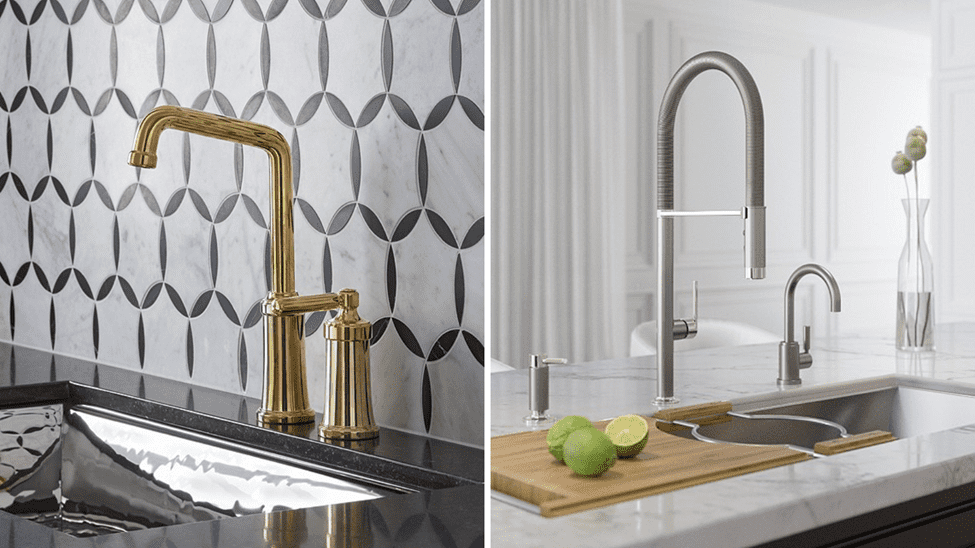
![Fireclay Vs Stainless Steel Sinks[7 Key Differences+Pros & Cons] Fireclay Vs Stainless Steel Sinks[7 Key Differences+Pros & Cons]](https://houseadorable.com/wp-content/uploads/2022/01/Fireclay-sink-3.jpg)
![Granite Vs. Marble Vs. Quartz Countertops [12 Differences+Pros & Cons] Granite Vs. Marble Vs. Quartz Countertops [12 Differences+Pros & Cons]](https://houseadorable.com/wp-content/uploads/2022/03/quartz-marble.jpg)
![16 Types of Kitchen Cabinet Finishes [Features + Pros & Cons] 16 Types of Kitchen Cabinet Finishes [Features + Pros & Cons]](https://houseadorable.com/wp-content/uploads/2022/10/cabinet-finish.jpg)
